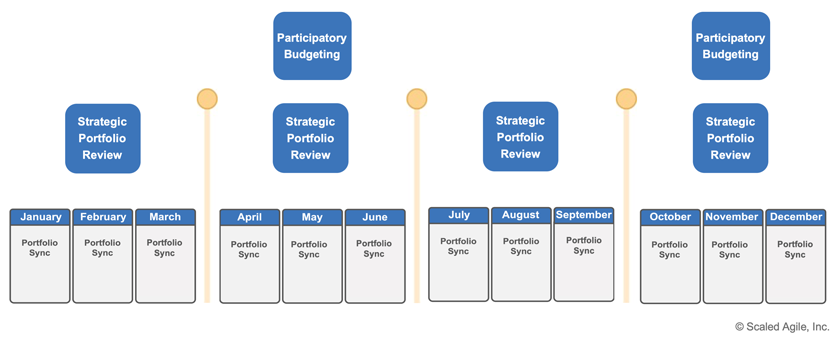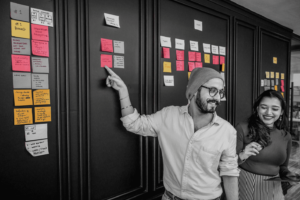SAFe® In a Nutshell – Portfolio Level
In the previous installment, we explored how to scale from a program to the large solution level which is used for organizations who are building really large systems requiring the collaboration and alignment of multiple ARTs. We covered the authorities and events involved. Now, we’ll explore SAFe® at the highest level, known as Portfolio, where strategy and high-level operations are centralized so that we can more easily decentralize execution of that strategy.
At this Portfolio level, it’s no longer about doing the work. Here, the focus is on why the work needs to be done — the business goals everyone is working together to achieve.
Roles
Technical Authority
The Enterprise Architect serves as Technical Authority at the portfolio level, serving much the same purpose as the Solution Architect. This Technical Authority is clearly reflected on the SAFe Big Picture, but what about the Execution and Content Authorities?
Execution Authority
Since this level has no direct connection to the work itself, the Execution Authority is not required and there is no direct equivalent of the RTE or STE here. However, the Agile PMO and Lean Agile Center of Excellence (LACE) collaborate with the SMs, RTEs, and STEs to achieve the required execution support. Generally, we’ll consider the Agile PMO as the long term owner of the execution at the portfolio level.
Content Authority
Instead, the Portfolio Management and Business Owners that operate at the Portfolio level are collectively considered the true Content Authority. Rather than being a singular person, the Content Authority is really a collaboration of enterprise executives, enterprise architects, and business owners in managing strategy and investment funding.
Epic Owner
Additionally, a portfolio backlog exists, comprised of epics that will be decomposed into capabilities. These large-scale initiatives have no set timebox and will often span multiple PIs. So, work is usually managed on a Kanban board for workflow visualization and adaptation. Epic Owners act as the champion for the epic to guide it through the Kanban process, but they are not considered the Content Authority. They are a specialized role, unique to the Portfolio level.
Other Roles
In other parts of SAFe, you may also come across a Solution Portfolio Manager, which some may consider the ultimate Content Authority at the Portfolio Level. However, this is never truly defined as a separate role in the SAFe Big Picture, and we’ll treat it as an abstraction of the collaboration associated with the three authorities.
An additional role at the Portfolio level that is not necessarily tied to any of the three authorities is the function of Lean Governance. This is a collaboration among the agile PMO, Business Owners, and Enterprise Architect in managing ROI and audit and compliance.
Artifacts
Strategic Themes connect the portfolio with the enterprise objectives. This can be thought of as the outcomes you’re looking to achieve, or a scaled up version of a PI objective. Along with budget, this is what starts the Portfolio down its path.
Once the strategic themes are finalized, you then want to put together a vision of your portfolio in terms of what it is going to be supporting in the future and the value it is going to be delivering. We capture that in a Portfolio Vision and within an artifact known as a Portfolio Canvas, which is the essence of the portfolio and paints a high level picture of what that portfolio includes.
Your strategic themes, along with your portfolio vision and some other elements, essentially produce a Portfolio Backlog, the highest level backlog within SAFe, which contains Epics, the largest pieces of work in the framework. It also includes Enabler Epics, pieces of work that don’t directly deliver business value, but enable the delivery of the business value.
Now, we have large initiatives, epics, and enabler epics sitting on the portfolio backlog. How do we move work through the portfolio level? We do so through the Portfolio Kanban system. At a high level, this is the process of work being in the funnel, to being reviewed, to being analyzed, to being approved, to the backlog, to going into the implementation state, and then ultimately being done.
It is the responsibility of the Content Authority to approve the epics that will progress through the Portfolio Kanban system to ultimately get implemented, while the Epic Owner drives the collaboration of all the roles that are necessary to gather the information and make decisions at each point in this process.
Ceremonies/Events
Figure 1: Typical cadence for the three LPM events (Source)
Strategic Portfolio Review
In this event, we decide which of our epics will continue to move through that portfolio Kanban system we just discussed above, along with which epics may be available to create features for and pull into the next PI planning session.
Essentially, we’re steering the portfolio with this event. Attendees include all stakeholders aligning and collaborating together in order to get input, move items through the portfolio Kanban process, and queue them up for possible inclusion in the next PI based on the Weighted Shortest Job First (WSJF) prioritization model.
Participatory Budgeting
During Participatory Budgeting, relevant stakeholders and Business owners determine the investments in value streams and approve epics in the portfolio Kanban. Generally, participatory budgeting and funding approval accounts for six months or approximately two PIs.
In SAFe, the ultimate goal is to move from a project funding model to a value stream funding model – we are not funding the work, but funding the team, which requires a decision on the work the teams should prioritize and accomplish within that two-PI window. Participatory budgeting therefore helps to inform not only how much money those different value streams will receive to operate, but also which epics are the most important to send to those trains. This will then inform how much funding is required depending on whether capacity needs to be increased or decreased.
Portfolio Sync
Somewhat analogous to the scrum of scrums in some ways, this sync happens on a more frequent basis, often monthly. The intention of the Portfolio Sync is to intentionally track the value realization of getting the work out into the market. During this event, there is an assessment of whether we should pivot, persevere, or stop. It’s important that this occurs on a regular basis depending on what we’re learning from the market.
Conclusion
In conclusion, this explains the roles, artifacts, and events that aid in execution at the Portfolio level. While the roles of content authority, execution authority, and technical authority still exist, we change the way that those functions are implemented through collaboration and ceremonies, in order to accommodate a more infrequent cadence while still pulling together all necessary data at this level.




